2022 Core Portfolio Annual Review and Outlook
January 2023
From the reader’s perspective, this document should be read in conjunction with the “Pathfinder Portfolio Management Overview” report released on January 6th, 2023, which explains our overall portfolio management process and investment thesis. Please follow this link here for a copy of the report if you have not seen it yet.
As we noted in our Portfolio Management Overview released earlier this month, 2022 was another historic year for global equity markets. Most markets finished the year lower than they started. We republish the chart to the right that was released in our Portfolio Management Overview. The countries are sorted from highest to lowest in terms of CAD return for comparability. The green bars show the absolute total return for Developed Markets and the grey bars are Emerging. The blue group represents the areas that we believe are more relevant to the typical Pathfinder client and the Canadian money management community. As you can see, the vast majority of the world had negative returns. There was also significant dispersion in Emerging Markets. Developed markets, on the other, were grouped together with mostly negative double-digit returns.
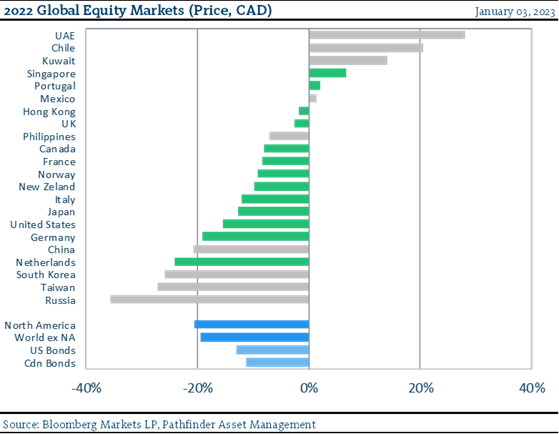
The other item that we added in the blue section was fixed income. Fixed income had equity-like returns last year, causing all sorts of difficulty for the traditional “60/40” Balanced Fund that the investment industry has come to rely on for risk mitigation over the past several decades. At Pathfinder, we have avoided long-term bonds in all of our mandates and client portfolios. This was a significant positive for those clients who had fixed income as part of their investment policy. Those clients also tended to tilt towards our High Income mandate, which has a large cash position and solid dividend-paying stocks that subsequently provided a positive return last year. On the following pages, we provide our mandate reviews and current investment outlook.
NORTH AMERICAN EQUITY & HIGH INCOME REVIEW
For the calendar year 2022, the North America Equity portfolio returned -7.8% and the High Income portfolio returned 0.9%. Since our inception in 2011, both of our segregated portfolios have returned 6.0% and 6.6% annualized to December 31, 2022 (please see Figure 2).
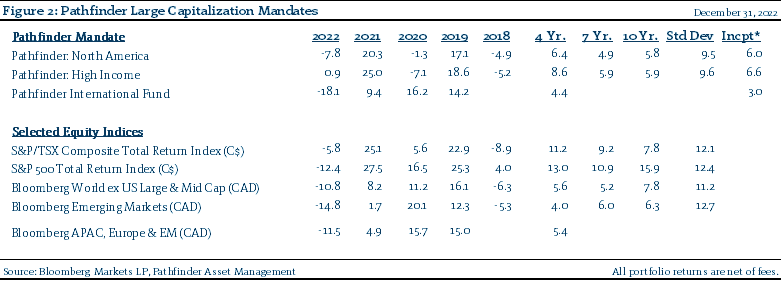
We have accomplished this while taking less risk vs. equity markets – between three quarters and two thirds of broad market indices, as measured by annualized standard deviation (the monthly fluctuations of your portfolio market value). We have been able to minimize our portfolio standard deviation with two main strategies. First, we invest in companies that are stable cash flow producers and are priced at a discount to their fundamental value. This should inherently lead to less volatile portfolios. Second, when the price of a share of a company that we own rises above what we think is the best-case scenario, we sell or reduce our position and allocate that cash to another company that has better value. If we cannot find another company, then we hold the cash in a treasury bill. Holding the cash serves two functions: One, it reduces the risk of the portfolio when we believe prices are too high and two, it provides us an option to buy more shares of good quality companies when prices are lower. It was a difficult year for stock picking with not many places to hide. In our North American Equity Portfolio, Canadian Natural Resources (CNQ CN) +40.7%, Fairfax Financial (FFH CN) +28.9%, Stella-Jones Inc (SJ CN) +21.3%, Cameco Corp (CCO CN) +11.3% and Canadian Pacific (CP CN) +11.1% were our best performers, while it was the technology stocks that were a drag for the year. Bank Of Nova Scotia (BNS CN) -25.9%, Fedex Corp (FDX UN) -28.4%, Alphabet Inc (GOOG US) -34.4%, Skyworks Solutions (SWKS US) -37.2% and Intel Corp (INTC US) -45.1% were the worst performers (all returns above do not include dividends).
There is a difference between trading the market and investing in companies. At Pathfinder, we invest in companies. We aim to buy good quality companies with stable cash flows at a low price. However, this year, we did much more trading than last year and were able to deploy cash at good valuations. We remain generally satisfied with our investment management execution; however, we felt we could have created more cash at the end of 2021 to act as a buffer. We did well putting it to work when markets were low in the spring and summer, but we had less cash into the downturn than other drawdown periods.
This year, the High Income portfolio had very good results when compared to other portfolios and market indices. We construct the portfolio primarily based on the current holdings of the North American Equity mandate. Those companies that offer attractive dividends are identified as potential for addition to the portfolio. We then look to the Core 100 for more opportunities, and finally after that, screen the markets for potential firms that fit our thesis. There are three important metrics that we focus on with respect to dividends:
1. The current yield of the stock or trust is important. There must be enough yield, paid as dividend or distribution, to act as a bond-like substitute for investors requiring cash flow for lifestyle purposes.
2. The second, and equally important metric, is the sustainability of the dividend. There has to be enough sustainable, repeatable cash flow generated by the company to ensure that, even during periods of stress, the probability of a dividend cut is low. There is also an element of management evaluation. For dividend sustainability to work, there must be a consistent management policy that pays a certain percentage of free cash flow out to the shareholder. If this policy is consistent, and we evaluate the company’s capability to protect free cash flow properly, then the dividend should hold over time.
3. Third is the ability of the company to grow its cash flow, and therefore its dividend in tandem over time. If the company can do this, then given that book value of the investor’s original position in the portfolio does not change, the yield-to-book should grow with inflation. In this case, we are less concerned about the current valuation of the stock, it can go up or down, but more concerned with the portfolio dividend flows based on invested capital. The result is an inflation-adjusted bond-like cash flow, but with equity portfolio volatility that the investor should ignore… so long as the dividends remains intact.
We present a comparison between the two mandates in Figure 3. The High Income Portfolio had more cash at the end of the year (10.4% vs 0.9%). Cash was also as high as 18% over the course of the year. This was a big plus that provided more downside protection during market volatility. The portfolio also had more energy exposure and more Canadian stocks, both of which were better when compared to the Equity Portfolio. High Income also has no technology or semi-conductor stocks. This meant that it avoided much of the significant drawdown from that part of the market. The portfolio also has better valuation metrics (PE, PS), which in theory would have provided more downside protection during periods of market stress.
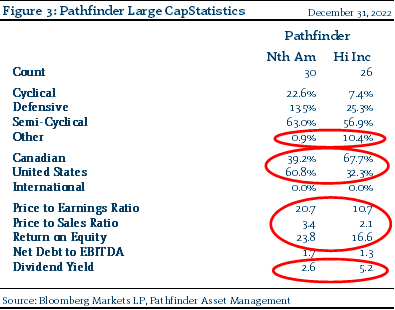
PATHFINDER INERNATIONAL FUND
For the year, the Pathfinder International Fund returned -18.1% while International Developed & Emerging Large/Mid Cap Markets were down -11.5% (both in CAD terms). International markets had a difficult year, particularly Emerging Markets in Asia. World Large & Mid Capitalization stocks returned -18.2% in USD terms. Large & Mid Cap Europe, Middle East and Africa markets were down -16.1%, while Large & Mid Cap Asian markets were down -17.6%. Emerging Asia stocks were down -21.6%. With the US Large & Mid cap market down -19.7%, there were limited places to allocate capital to avoid difficult markets. A combination of poor economic conditions and geopolitical issues caused investors to flee international risk capital in place of USD assets in early 2022.
The main reason for the difference is the fund’s performance relative to “the market” was its high exposure to China and technology stocks in general (please see Figure 4). Both were difficult places to be for the year and also less represented in the broad indices as in the fund. We believe this will be temporary. We have not changed our themes that we identified in 2019 and still focus on technology (hardware, ecommerce and industrial electrification), banking and retail in Asia, along with a few commodity special situations. We will, however, add more industrial stocks to the portfolio when we have confirmed a trough in the global economy. We suspect that we are at a cyclical low, and the companies that we invest in at this point in the cycle will have excess growth for years to come, as the global economy recovers, supply chain issues subside, and inflation eventually moderates. Our main task is to identify the emerging themes and geographic areas that will benefit from these large medium to long-term structural trends. Then we need to add the companies that are globally the best positioned and valued to exploit those opportunities.
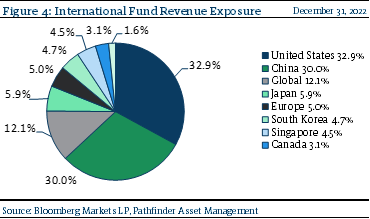
Our best performers for the year were DBS Group (D05 SP) 11.8%, Cameco Corp (CCO CN) +11.3%, Emerson Electric (EMR US) 10.5%, Fairfax India (FIH.U CN) 4.2% and Ivanhoe Mines (IVN CN) +3.7%. Note that none of the strong Asian technology stocks from the previous year are in the list. This year, the drawdown in Chinese stocks continued in dramatic fashion but was followed by a sharp rally in December that has also continued into January as we write this report. In addition, chip manufacturing struggled in what was, in our view, temporary inventory over supply. The worst performers this year were: Tokyo Electron (8035 JP) -45.4%, Coupang Inc (CPNG US) -46.4%, Nvidia Corp (NVDA US) -46.9%, Sunny Optical (2382 HK) -59.7% and Kion Group Ag (KGX GR) -72.2% (all returns above do not include dividends).
Much like the North American Equity Portfolio, the International Fund is now essentially fully invested. We could have been more aggressive about risk mitigation at the beginning of the year and done more to protect the downside. We had previously shorted stocks during stress periods but missed that opportunity early in the year. This was the main driver of our drawdown, as for the most part, we remain very comfortable with the companies that we own.
CORE PORTFOLIO STATISTICS
We include Figure 5, which presents the difference between the Pathfinder Large Cap mandates and three large exchange trade funds and indices. We think that this is the most appropriate comparison for our approach. Pathfinder mandates do not look like any common benchmark portfolio. We are more concentrated, have better valuation metrics and stronger company fundamentals. Over the years, our allocation to sector, geography and cash have changed dramatically. We take a real investment stance, move capital opportunistically and, as a result, expect a more efficient return profile. We cannot guarantee better performance, but we can guarantee that we will be different. In our opinion, this is what most investors are missing in their own personal investment structure. When we speak with clients and prospects, we often tell them that they have three basic options for the operation of their investment portfolio:
1. “do it yourself”
There are many “do it yourselfers” and if one is interested, diligent and has the time to dedicate, this is a great way to manage a portfolio. It permits maximum flexibility and is clearly the cheapest. However, individual results can vary, and most people are often not objective about evaluating themselves;
2. and/or “index”
The second cheapest is passive investing, which is also a very valid approach. In this case, a very low-cost ETF and a long-term strategy (i.e. avoid selling in the panic times) guarantees average returns with an essentially institutional type fee;
3. and/or “hire a pro”
Many people also hire a professional investor. This unfortunately comes with mixed results. There are some great money managers who offer performance and good service but there is an associated fee. In some cases, it works and in others it does not. Many professional investor services also rely on outsourced money management and, in turn, blend multiple portfolios together, essentially creating a passive portfolio with an active fee. This guarantees that the client earns subpar returns and ultimately leads to a poor client experience. When hiring a money manager, the “buyer beware” philosophy holds very true.
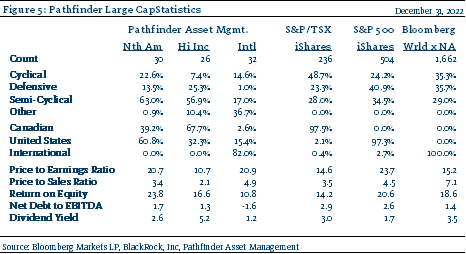
I added the “and/or” in front of each option because we find that some of the most interesting client portfolios mindfully blend multiple approaches. The trick is to be mindful with the selection of the strategies. At Pathfinder, our Investment Counsellors are actively involved in helping clients do this.
A NOTE ABOUT FIXED INCOME:
We have several clients where we blend in a laddered, investment-grade fixed income portfolio to their equity and fund positions for risk mitigation and capital preservation purposes. We have often stated that given the interest rate environment, we did not view fixed income as a source of investment return but rather as a store of nominal value (i.e., loss of capital is limited, other than erosion from inflation).
During the early part of my career, a typical client’s Investment Policy Statement could be wrapped around a balanced portfolio (60% equity, 40% fixed income). The bond portion of the portfolio was usually targeted to provide cash flow for a fixed liability (living expenses, for example) and the equity portion of the portfolio was used for growth to build the portfolio in order to protect its purchasing power over time. That changed in the mid 90’s as long bond rates dropped below 6%. While there was an initial, (significant) capital gain, once the tenor rolled off and the bond matured, it was very difficult to reinvest for any duration that paid what we thought was a reasonable rate, given that interest rates were eventually bound to increase again. The longer the low rate environment persisted, the riskier it was to add long bonds to a portfolio because of the substantial capital loss that would occur on rate reversal. Earlier this year, rates did in fact reverse. We wrote a market cap series that showed total wealth destruction (equity losses added to fixed income losses), was almost equal to the wealth that was destroyed in the Great Financial Recession of 2008. Please follow this link here to review.
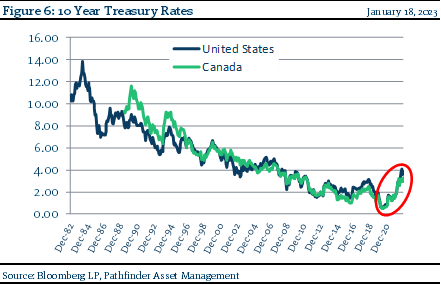
For our Fixed Income Portfolio, we have remained allocated to short duration bonds. This is a good way to preserve capital as they are less sensitive to interest rates. We also believed that credit spreads have been too small to warrant investment in most corporate bonds and we have tilted the portfolio more towards government bonds. We said that we would need to see mid-to-high single digit bond rates with moderate inflation before we would again consider it as a contributing part of our investment process.
For clients that require fixed income for living expenses, we have historically substituted our High Income portfolio for the equity portion of the investment policy statement and used our short bond ladder for the fixed income portion. This has resulted in exceptional relative performance for these investors.
With interest rates increasing, we now consider fixed income as a potentially viable investment alternative if (and this is a BIG IF) we can see some moderation in core inflation. We have now begun the process of working fixed income into our regular investment process and will monitor markets very carefully for opportunities to modify client portfolios where a balanced approach makes sense. We will write more on this in the future as the situation evolves.
CURRENT INVESTMENT OUTLOOK
Every year, we reread what we wrote the previous year in this section. We compare what we thought the coming year would bring against what actually happened. One of the nice things about writing on a regular basis is that we can track how our thought process evolves. This provides us with the opportunity for reflection, which is critical for investors. We did the same thing with last year’s Current Investment Outlook section before we began to write this year’s and we were struck again by how quickly inflection points can present themselves. War in the Ukraine and the change in investor expectations happened very fast at the beginning of 2022. We entered a bear market quickly.
One of the most obvious differences between this and prior big bear markets was the performance of fixed income. For decades, the 60/40 balanced fund (60% equity and 40% fixed income) had been the foundation of most investor portfolios with fixed income offering a buffer against the volatility of equities, particularly during drawdown periods. As Figure 7 presents, this was not the case this year for fixed income (grey line). It performed much like equity, when many investors would have expected it to do the opposite.
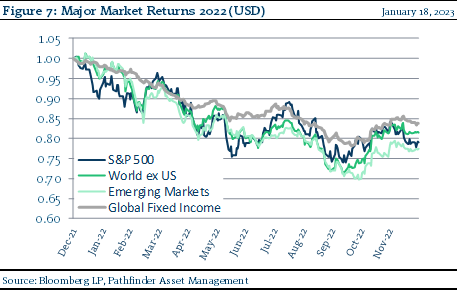
During periods of distress, capital typically flows to the safest asset and during the upheaval of last year, it was US Treasury bills that took most of the flow. This, in combination with US companies being less exposed to war in Europe, Canadian companies having more energy exposure, and both being less exposed to poorly envisioned policy in China (COVID & company sanctioning), resulted in better performing North American equities in local dollar terms.
These were the two largest drivers of returns last year. A portfolio that was equally focused on large capitalization North American stocks and a short-term fixed income portfolio was able to provide a much better relative return than a traditional balanced or international portfolio. The fixed income observation should not be discounted. It was a material destroyer of wealth this year. However, a significant difference between equity and fixed income losses is that companies can regroup and improve profitability over time to the benefit of equity holders. These periods of distress are often buying opportunities for high quality organizations and over time, and these type of investments usually work out. It is different for a bond. The only way for a bond to recover after interest rates have risen is for those same rates to drop back down to where they were before. Given that rates were at generational lows, and there appears to be sustained and stubborn high inflation, we believe the losses in recently issued long-term bonds are unfortunately permanent for those investors.
The big question on everyone’s mind (investors and consumers alike) is what will happen with inflation. Inflation has not been this high since the early 1980’s and its forward path has significant implications for investors. Figure 8 presents Personal Consumption Expenditures (PCE), which is the Federal Open Market Committee’s preferred inflation measure. When the PCE falls to around 2%, we will be back in a “normal inflationary environment” (the dark blue line has been around 2% since the early 1990s). We have also included traditional CPI, which is often quoted in the financial press. It appears that both have peaked in the early spring. Will inflation rise back above the recent highs? That is a critical question. So far, we have seen some disinflationary pressure: supply chains are normalized and cost of goods have somewhat moderated. What remains a concern for higher inflation is wages and services. The low unemployment rate and the potential impact of a re-emerging China on demand, including oil, could also drive inflation higher. Figure 9 presents goods inflation (peaked) and services inflation (yet to peak) along with the unemployment rate (all-time lows).
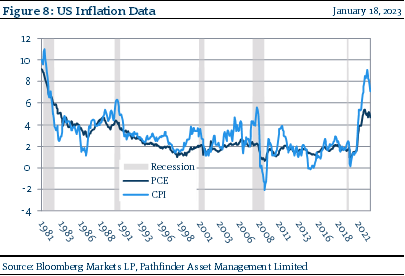
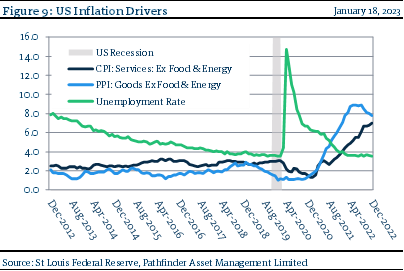
We present in Figure 10, headline inflation data from other parts of the world. What strikes us is how different each of the major areas are. While there is recent disinflation in the US, Brazil and Europe, Japan has still yet to reach its peak. Note that at Japan’s current inflation rate of 3.8%, it is well below that of other major economies, as for decades, deflation has been the issue in Japan. China is essentially on its own with (so far) low inflation and no perceivable pattern. As China reopens, one can only expect that this number will rise and have an impact on the rest of the world.
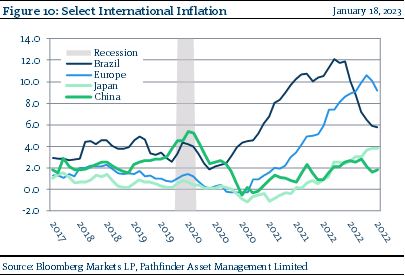
What we find most interesting about the current situation is how different the economies are. In recent history, most major economies have moved in tandem. It appears now there are significant differences (including with geopolitical issues as well). This provides an opportunity for diversification that we should be able to us in the construction of the portfolios.
We published The Buffett Valuation (broad US stock market capitalization divided by US GDP) for the last 50 years in Figure 11. It was at an all-time high last year at this time and has since moderated back to 2018 levels. This is a large adjustment but remains high historically. The peak of the dot-com bubble from the late 1990’s was about the same as today.
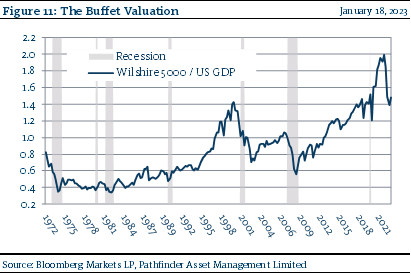
We also published Price Earnings multiples for US and International stocks in Figure 12. Valuations have peaked but have yet to find a bottom. We see this in the portfolios now, as many share prices have fallen below what we consider to be fair value. This means there is more opportunity to buy companies. Adding them to the portfolio today is more attractive, particularly on the international side, than it has been at any time since 2018.
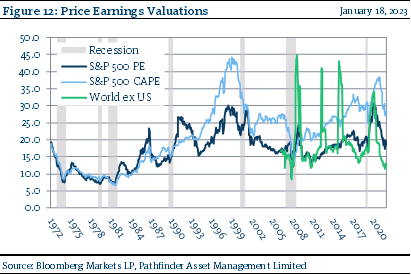
Figure 13 presents management expectations as measured by Purchasing Managers Indices, which have been understandably somewhat volatile since the recession. Unfortunately, on average, they have recently turned below 50, which means there is a negative outlook. This is not a constructive development.
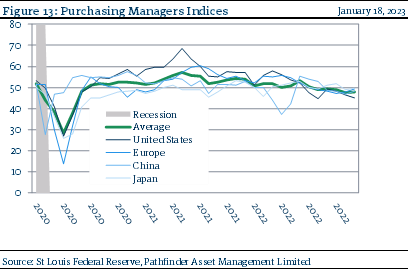
Conclusion: We will continue to look for good quality, mispriced investments. The combination of better valuations and moderating inflation provide the opportunity to position the portfolio for the next cyclical expansion. Over the long term, our investment view remains unchanged.
CORE:100
We maintain a list of what we consider to be world class companies in all industries and across all major geographic areas. We regularly screen global stocks, based on our valuation framework, for new names that we consider for addition to our universe of coverage. We focus on well managed, fundamentally strong firms that consistently generate and grow cash flow. We also expect strong quality management teams to reinvest that cash flow in improving their businesses. These firms have defensible advantages and ideally return any excess capital to their owners (i.e. us!!) in a rational, economic and consistent manner. The list is then filtered for qualitative factors including sector balance, general economic trends and changes in technology and we generate buy and sell targets for each company in the universe. This is what drives our portfolio investment decisions. Our thesis is that these companies should do better than the general market over the long-term and, more importantly, they should outperform during the regular periods of distress that we seem to have every 7-10 years. If we are buying from a list of “the best companies in the world” and buying consistently at a discount, then the portfolios that we construct should do better on a risk-adjusted basis as well.
We have expanded past our 100 names in the Core 100 as we find new additions and our investment thesis evolves to include more international companies. Generally, this is a slow-moving process that does not change significantly from year-to-year, but some evolution is healthy given global changes and the ongoing development of our investment view and process. In 2022, we had limited movement of companies. We did lose a handful to M&A activity. Given the recent turmoil in economies from the various reactions to COVID and now with major geopolitical changes, we have reserved adjustment for this past year and expect significant turnover next. The number of companies that we follow in detail will increase towards 150 over the short term and hope to find more companies that are more domestic in nature, rather than the large multi-nationals. We believe that companies focused on a more nationalistic approach will be less at risk to geopolitical changes than the other super majors. Figure 11 presents our current characteristics against large exchange-traded fund portfolios and indices. As you can see, our metrics tend to be more value focused with less leverage than the board markets.
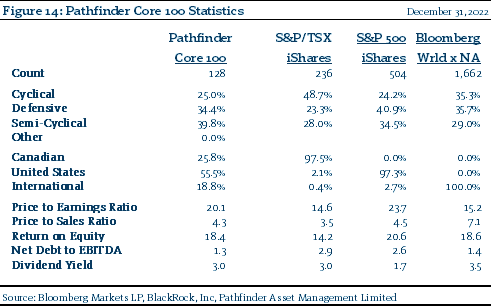
We are always looking to improve the quality of the companies that we consider for the portfolios. We run screens that identify new companies that fit the broad parameters of what we consider to be a “good” company. The list is continually expanding and over the coming year it will be reviewed to determine if there is a potential fit for the Core 100.
National Instrument 31-103 requires registered firms to disclose information that a reasonable investor would expect to know, including any material conflicts with the firm or its representatives. Doug Johnson and/or Pathfinder Asset Management Limited are an insider of companies periodically mentioned in this report. Please visit www.paml.ca for full disclosures.
*All returns are time weighted and net of investment management fees. Returns from the Pathfinder Partners’ Fund and Partners’ Real Return Plus Fund are presented based on the masters series of each fund. The Pathfinder Core: Equity Portfolio and The Pathfinder Core: High Income Portfolio are live accounts. These are actual accounts owned by the Pathfinder Chairman (Equity) and client (High Income) which contain no legacy positions, cash flows or other Pathfinder investment mandates or products. Monthly inception dates for each fund and portfolio are as follows: Pathfinder Core: Equity Portfolio (January 2011), Pathfinder Core: High Income Portfolio (October 2012) Partners’ Fund (April 2011), Partners’ Real Return Plus Fund (April, 2013), and Partners’ Core Plus Fund (November 2014).
Changes in Leverage. We are increasing the liabilities ceiling to 2.0 times the market value of equity for Pathfinder International Fund and Pathfinder Real Fund to be consistent with Pathfinder Partners’ Fund and Pathfinder Resource Fund.
Pathfinder Asset Management Limited (PAML) and its affiliates may collectively beneficially own in excess of 10% of one or more classes of the issued and outstanding equity securities mentioned in this newsletter. This publication is intended only to convey information. It is not to be construed as an investment guide or as an offer or solicitation of an offer to buy or sell any of the securities mentioned in it. The author has taken all usual and reasonable precautions to determine that the information contained in this publication has been obtained from sources believed to be reliable and that the procedures used to summarize and analyze such information are based on approved practices and principles in the investment industry. However, the market forces underlying investment value are subject to sudden and dramatic changes and data availability varies from one moment to the next. Consequently, neither the author nor PAML can make any warranty as to the accuracy or completeness of information, analysis or views contained in this publication or their usefulness or suitability in any particular circumstance. You should not undertake any investment or portfolio assessment or other transaction on the basis of this publication, but should first consult your portfolio manager, who can assess all relevant particulars of any proposed investment or transaction. PAML and the author accept no liability of any kind whatsoever or any damages or losses incurred by you as a result of reliance upon or use of this publication.